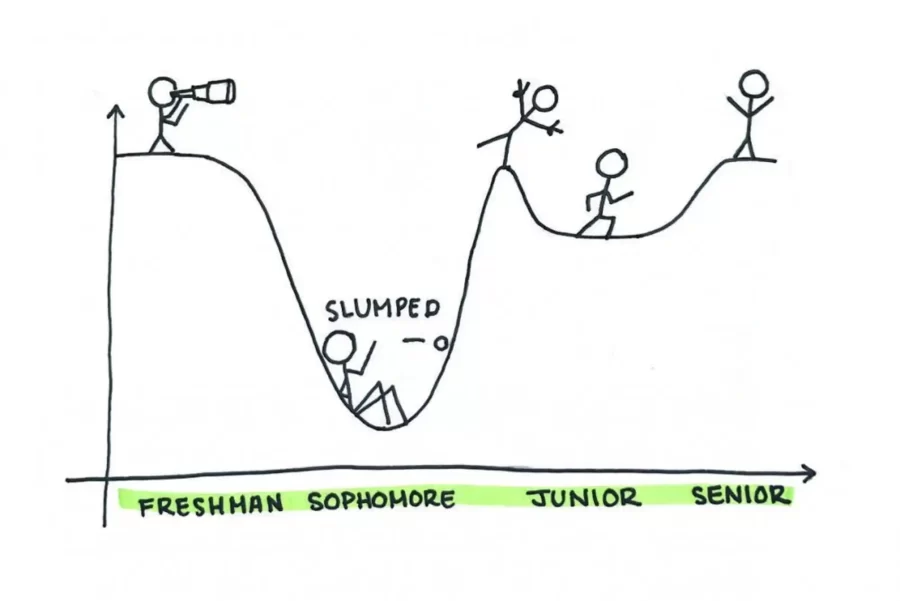Grade Culture on Students
Do grades really matter?
One sunny February afternoon, a friend of mine and I were chatting, and the topic of tests came up. She had just taken a pretty bad one the other day and was unhappy with her grade. We got to speculating on the topic of our grades in past years, and we came to a shocking realization: neither of us could remember the last time we had gotten a 100% grade! I myself hadn’t gotten a 100% score on a test since seventh grade. This brought up so many questions: was I not trying hard enough? Or were my teachers grading more harshly now that I’m older? I have been putting so much of my free time and effort into school, so why is it not good enough? As it happens, many students have the same questions.
The concept of grades has had and continues to have many critics. Why? Grades can affect the mental health of students by putting too much pressure on them to succeed, inaccurately measuring their intelligence (different forms of intelligence are not tested), and impressing upon them the idea that, if their grades aren’t perfect, they won’t succeed in life.
Why were “grades” created in the first place?
The idea behind grading systems in schools was to help teachers and gauge students’ understanding of a topic. Originally, a student’s understanding of a topic was discussed among teachers and scholars and decided through argument, not a set system. One article from Slate.com reads, “U.S. colleges employed the Oxford and Cambridge model … students attended regular lectures … students were determined to have completed the course when the proctor, and sometimes a panel of other professors, decided … [they had] adequate mastery of the subject.” However, as more people had access to education (specifically in the United States but also in other places) teachers required a more rigid and organized fashion of judging children’s understanding of the curriculum. Hence the birth of the letter system.
The letter system, assigning letter-named classes to grade averages (for example, A is 100% to 90%), has had its fair share of changes. It once had an E instead of F to signify failure to learn a subject, it sometimes had uneven grade assignments such as “A representing scores between 95 and 100, while B and C each stood for 10-point ranges,” even some schools have removed the D grade in order to get their students to “strive for greatness.” Some early versions of the system didn’t even allow the students to see their grades, so they could focus on learning. All of these systems, however, are flawed.
Why grades can portray people in inaccurate and harmful ways
The idea behind assigning constantly updated grades to students was to push them to chase success, giving them a blueprint to figure out which areas they need to improve on. However, unfortunately what has happened is students have assigned not only all of their time and effort into getting A grades, but they’ve also assigned their self-worth to whether or not they get them. Most letter systems are too rigid to accurately represent mastery. What if a student was suffering from a terrible occurrence on a test day and performed poorly, therefore completely uprooting their grade? Or, what if a student is actually really good at a subject but has intense anxiety surrounding tests that prevents them from scoring well? Grades show no empathy.
Students have been fed this concept that only lazy people or slack offs get bad grades, so if they do the same, they’ll be seen as a “bad kid”. This just isn’t true. What if a student needs more time to understand a subject? They could be the best ever at that topic, but all their grades would reflect is a flunked test sprung on them too early in their road to understanding. And, in most cases (GALA thankfully excluded) these tests, and assignments are one and done: no backsies. A pupil will have one bad test and not be able to make it up, knocking down their grade. This, in turn, has the opposite effect of what was originally expected, that students would strive for greatness and learn better. Their learning is actually stunted by the fact that they don’t get any second chances to grasp a subject before a grade just decides they are bad at it. I personally, as many do, actually develop “grudges” against topics after one or repeated bad experiences with them, usually tests, so that in the future if those topics come up, I don’t even attempt them. Who knows, given the proper time and support I could’ve grown to love those concepts! I could’ve fallen in love with geometry!
Can grades be used in a productive and positive way?
Yes! The concept of grades as encouragement can absolutely be achieved through tweaks, and by using other accompanying systems to supplement them. For instance, GALA’s own mastery grading system, where students are given as many times as they need to get their grades up on tests/assignments, focusing on conquering topics through repeated attacks if needed, rather than only first-time attempts. This allows grades to be used as they were intended, like a tool, a measurement that can be improved through targeted practice, rather than a punishment for missing the first shot. An absence of “end all be all” grades, for me at least, coming from a standard grading previous school, has made it significantly easier and less stressful to achieve and more importantly learn.
In conclusion, grades can be a helpful tool to motivate students to reach their goals and pinpoint where their understanding may be lacking, but they are only effective when they are distributed with purpose and empathy.

Johanna M (but you can call her Jo) is a junior at GALA and is excited to start her second year as an Echo staff writer. She is dedicated to...





































































































